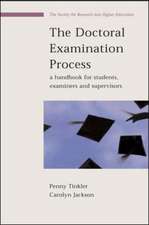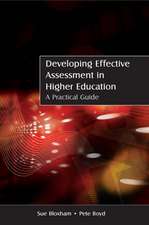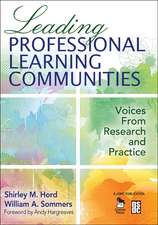Online Learning and Teaching in Higher Education
Autor Shirley Bach, Philip Haynes, Jennifer Lewis Smithen Limba Engleză Paperback – 15 dec 2006
Preț: 441.42 lei
Nou
Puncte Express: 662
Preț estimativ în valută:
84.47€ • 87.69$ • 70.44£
84.47€ • 87.69$ • 70.44£
Carte tipărită la comandă
Livrare economică 22 martie-05 aprilie
Preluare comenzi: 021 569.72.76
Specificații
ISBN-13: 9780335218295
ISBN-10: 0335218296
Pagini: 200
Dimensiuni: 150 x 230 x 13 mm
Greutate: 0.37 kg
Editura: McGraw Hill Education
Colecția Open University Press
Locul publicării:United Kingdom
ISBN-10: 0335218296
Pagini: 200
Dimensiuni: 150 x 230 x 13 mm
Greutate: 0.37 kg
Editura: McGraw Hill Education
Colecția Open University Press
Locul publicării:United Kingdom
Cuprins
Chapter
One:
Drivers
to
online
learning
I.
Social
and
political
change
II.Technical and intellectual challenges
III.Technological and institutional change
IV.Influence of USA and Australia + Northern Europe
V.Mass Higher Education
VI.IT Skills
VII.Students’ lifestyles
VIII.Part time to full time work
IX.International HE Market
X.Web / Internet growth
XI.Dearing Report/ Harris Lifelong Learning
XII.JISC
Chapter Two: Where to begin with online learning
I.What technology is available and desirable
II.Orientating to online learning – staff preparation
III.Identifying student suitability for online learning
IV.Pre-assessment of self
V.Learning styles and online learning
VI.Role of personal tutor
VII.Androgogy
VIII.Modes and levels
IX.Learning philosophies
X.Attitudes towards IT
XI.Possibilities
XII.Deep and surface learning
Chapter Three: Institutional and regulatory issues
I.Assessment/ examination
II.Attendance
III.Boundaries
IV.Online submission
V.External examination
VI.Plagiarism
VII.Quality assurance
VIII.Online information Sources – e.g electronic journals
IX.Regulations
X.Intellectual property
XI.Institutional checklist for learning projects
Chapter Four: Design of Online Learning Environments
I.Influence of SENDA on practice and learning
II.Technical design
III.Structuring the environment
IV.Special interest/ Subject/ professional interest
V.Navigation
VI.Time management
VII.Replicating environments classroom activity
VIII.Structuring the environment
IX.Learning spaces
X.Learning communities
XI.MLE/VLE
XII.Consistency of Design
XIII.Managing large groups
Chapter Five: Learning Methods
I.Distance versus blended approaches
II.Asynchronous conferences
III.Synchronous conferences
IV.PowerPoint
V.Video and audio
VI.Simulations
VII.Virtual classrooms
VIII.Factors restricting choice e.g. bandwidth
IX.Conclusion the challenge of meshing technology with teaching
Chapter Six: Applying online learning in Higher education
I.Lectures
II.Seminars/small groups
III.Dissertations and projects
IV.Action learning
V.Problem based learning
VI.Workbased based learning
VII.Tutorial support
VIII.Assessment methods
Formative summary essays, exams and multiple-choice questions
Index.
II.Technical and intellectual challenges
III.Technological and institutional change
IV.Influence of USA and Australia + Northern Europe
V.Mass Higher Education
VI.IT Skills
VII.Students’ lifestyles
VIII.Part time to full time work
IX.International HE Market
X.Web / Internet growth
XI.Dearing Report/ Harris Lifelong Learning
XII.JISC
Chapter Two: Where to begin with online learning
I.What technology is available and desirable
II.Orientating to online learning – staff preparation
III.Identifying student suitability for online learning
IV.Pre-assessment of self
V.Learning styles and online learning
VI.Role of personal tutor
VII.Androgogy
VIII.Modes and levels
IX.Learning philosophies
X.Attitudes towards IT
XI.Possibilities
XII.Deep and surface learning
Chapter Three: Institutional and regulatory issues
I.Assessment/ examination
II.Attendance
III.Boundaries
IV.Online submission
V.External examination
VI.Plagiarism
VII.Quality assurance
VIII.Online information Sources – e.g electronic journals
IX.Regulations
X.Intellectual property
XI.Institutional checklist for learning projects
Chapter Four: Design of Online Learning Environments
I.Influence of SENDA on practice and learning
II.Technical design
III.Structuring the environment
IV.Special interest/ Subject/ professional interest
V.Navigation
VI.Time management
VII.Replicating environments classroom activity
VIII.Structuring the environment
IX.Learning spaces
X.Learning communities
XI.MLE/VLE
XII.Consistency of Design
XIII.Managing large groups
Chapter Five: Learning Methods
I.Distance versus blended approaches
II.Asynchronous conferences
III.Synchronous conferences
IV.PowerPoint
V.Video and audio
VI.Simulations
VII.Virtual classrooms
VIII.Factors restricting choice e.g. bandwidth
IX.Conclusion the challenge of meshing technology with teaching
Chapter Six: Applying online learning in Higher education
I.Lectures
II.Seminars/small groups
III.Dissertations and projects
IV.Action learning
V.Problem based learning
VI.Workbased based learning
VII.Tutorial support
VIII.Assessment methods
Formative summary essays, exams and multiple-choice questions
Index.














